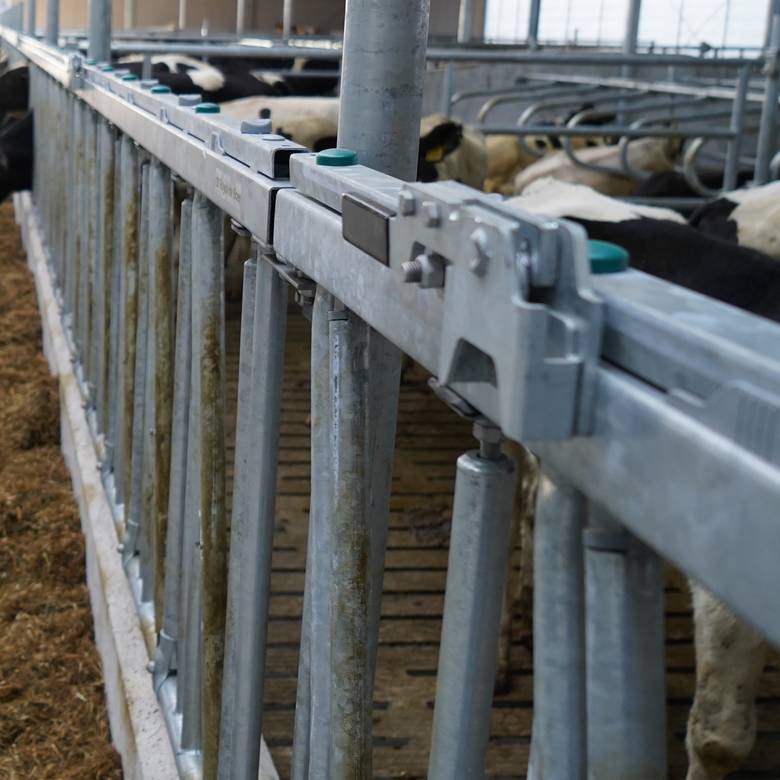
Custom feeding fence
This fence was designed as a safety feeding fence. This means the space between the fixed stanchion and the retaining stanchion at the bottom is large enough to ensure the cow, if she were to slip, can withdraw her head from the feeding fence even at this height. That way, she can free herself without any assistance.
The feeding fence is available in various feeding widths. The “standard” width of 65 cm per cow is still the most conventional variety. However, it is gradually being replaced by larger sizes. Our assortment also includes fences with a feeding width of 70, 75 or 78 cm. The fences themselves are available in various lengths and, through the application of longer components, can be adjusted for larger openings.
The feeding fence has an interior height of 90 cm and an exterior height of 102 cm, making the fence suitable for larger cows, too. The neck width measures 20 cm, which suits most dairy cow breeds.
The Twist&Lock feeding fence is easy to operate and offers plenty of space for the cow's head. Thanks to the unique Twist & Lock feature, the animals can be released or secured individually. The use of low noise materials prevents excessive noise production during opening and closing of the catch bars.
Creating an entrance large enough for people is easy. Special walk-through brackets are available for this purpose. A more straightforward entrance can be made by leaving space between the 2 support posts. In order to keep your clothes from getting caught on objects, rounded components are available.

Control options
With a control lever, about 30 metres of feeding fence can be centrally locked or opened. The catch bars is locked when the cow puts her head through the opening and reaches for the feed.
Using the knob placed on the feeding fence above each opening allows you to lock individual cows, while the remaining animals of the group can be released using the controler lever. This is convenient if you want to keep a few individual animals behind for treatment.
Conversely, using the unlocking knob allows you to release individual animals, while the remaining animals are kept in place. This is convenient if you need to separate one or multiple cows.
The control knobs are very user-friendly, which sets these fences apart from many other safety feeding fences available on the market.
Another feature involves the central closing function. You can use this to centrally lock the catch bars. This way, the cows will no longer be able to reach the feed. This is convenient if you want to drive the animals to the milking parlour along the fence and feed them after milking.
The feeding fence can also be mounted at a forward angle. That way, the animals have more space to reach the feed. This results in less “leaning” against the feed fence.

Technology
Technologically, the fence is of a solid construction. A rectangular tube at the top and a 60mm pipe below, connected by 1” connecting tubes, form a robust frame.
The catch bar is locked by plastic latches integrated into the upper profile on top of the feeding fence, keeping them dirt free and quiet. By moving the upper profile with the central control lever, the feeding fence is set to catch or release.
The pivot of the retaining stanchion is completely rounded and does not have any protruding bolts. The catch bar retaining stanchion has a bearing with a bronze bush to ensure years of wear-free functionality.
The bottom of the catch bar contains a plastic fall pipe to prevent cows from getting their collars stuck at the catch bar.
The fences are mounted on 2.5” or 3” vertical posts using mounting sets. Mounting components suitable for bigger supports are also available. The mounting components can be used to freely extend the fences by 5 cm. This way, a feeding fence can be extended by a maximum of 24 cm.




